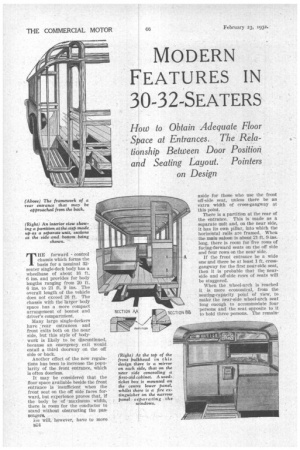MODERN EATURES IN 0-32-SEATERS
Page 58

Page 59

If you've noticed an error in this article please click here to report it so we can fix it.
Hipw to Obtain Adequate Floor SiSace at Entrances. The Rela tionship Between Door Position and Seating Layout. Pointers on Design THE forward control chassis which forms the basis for a nominal 32seater single-deck body has a wheelbase of about 16 ft. 6 ins, and provides for body lengths ranging from 20 ft. 6 ins. to 21 ft. 9 ins. The overall length of the vehicle does not exceed 26 ft. The chassis with the larger body space has a more compact arrangement of bonnet and driver's compartnient.
Many large single-deckers have ,-rear entrances and front exits both on the near side, but this style of bodywork is likely to be discontinued, because an emergency exit would entail a third doorway on the off side or back.
Another effect of the new regulations has been to increase the popularity of the. front entrance, which is often doorless.
It may be considered that the floor space available beside the front entrance is insufficient when the front seat on the off side faces forward, but experience proves that, if the body be of 'maximum width, there is room for the conductor to stand without obstructing the passengerS, ike will, however, have to move B21 aside for those who use the front off-side seat, unless there be an extra width of cross-gangway at this point.
There is a partition at the rear of the entrance. This is made as a separate .unit and, on the near side, it has its own pillar, into which the horizontal rails are framed. When the main saloon is about 21 ft. 9 ins. lung, there is room for five rows of facing-forward seats on the off, side and four rows on the near side.
If the front entrance be a wide one and there be at least 1 ft. crossgangway for the first near-side seat, then it is probable that the near-side and off-side rows of seats will be staggered.
When the wheel-arch is reached it is more economical, from the seating-capacity point of view, to make the near-side wheel-arch seat long enough to accommodate four persons and the seat opposite to it to hold three persons. The remain
lag portion of the body is utilized for two -crosswise seats on the off side and one on the near side. There
is then a total of 31 seats.
With a rear entrance and the same overall length of saloon, there is no difficulty in maintaining the same seating capacity. Again, one may have a doorleSs entrance, the accessibillf.y of which is increased by recessing the rear part of the saloon in order that the step may • be g.Pproactied froth, the rear.
The seating plan, forward of the wheel-arch, consists of five pairs of crosswise seats, a pair of triple wheel-arch seats and, finally, two transverse rows, the back bank holding four passengers. The total is 32 seats.
The disadvantage of this arrangement is that the conductor cannot stand against the rear bulkhead, • also the legs of the passengers on • the back seat tend to obstruct the passage-way to and from the entrance. To give more floor space, either the back seat may be shortened, or the last two rows of cross-wise seats may be omitted, the off-side wheel-arch seat being continued to the back of the body. As wheel-arch seats are several inches' higher than the transverse ones, it is customary to provide them with a raised platform so that the height from the top of this to the cushion is about the same as between the cushion and floor of the other seats.
A similar idea is adopted for cross-wise seats close to the wheelarch position. The floor is raised on each side of the central gangway litf-d-tIfewheel-arch obstruction is thereby reduced. The obstruction remaining is, however, of sufficient height to demand a wide spacing of the rows of seats immediately in front of and behind the wheel-arch.
A 30-seater central-entrance bus can be obtained with or without doors to the entrance. The doors are usually hung at the top of the step and open outwards. The body
is strengthened by a partition on each side of the doorway. These partitions are repeated on the off side and enclose lengthwise seat. From the service point of Tiew, a lengthwise seat opposite the entrance is a good feature, because additional free floor space is available where it is most required. As the majority obthe passengers faces forwards, the front bulkhead
is a prominentleature. .
' A mirror 'under the 'roof :on-the near side may be mounted on a hinged flap,-which gives access to a locker forTed under the roof canopy.
A used-ticket box on the front bulkheadof a front-entrance bus is More likely to be used than one which is at the rear entrance, because in the former instance it is continually under observation.




































































































